The Media Presentation of NZ Youth in Public Spaces: Report
VerifiedAdded on 2022/10/12
|13
|3099
|465
Report
AI Summary
This report analyzes the media presentation of NZ youth in public spaces, focusing on the portrayal of crime. It examines four articles from the New Zealand Herald, summarizing each and identifying common themes related to youth crime, including robbery, theft, and violent offenses. The analysis explores the potential impact of media portrayals, considering whether they create a negative or positive perception of young people. The report critically evaluates the selected articles, referencing relevant research to assess the accuracy and potential biases in the news coverage. The study considers various factors such as reckless behavior, criminal mentality, economic conditions, and the role of the media in shaping public perception. The report also includes a critical evaluation of the news portrayal, discussing the term "Youth crimes" and the factors that can be associated with the crimes. The report concludes with a reflection on lessons learned from the project and course.

Paraphrase This Document
Need a fresh take? Get an instant paraphrase of this document with our AI Paraphraser

Full Name
Student I.D.: #####
Student I.D.: #####
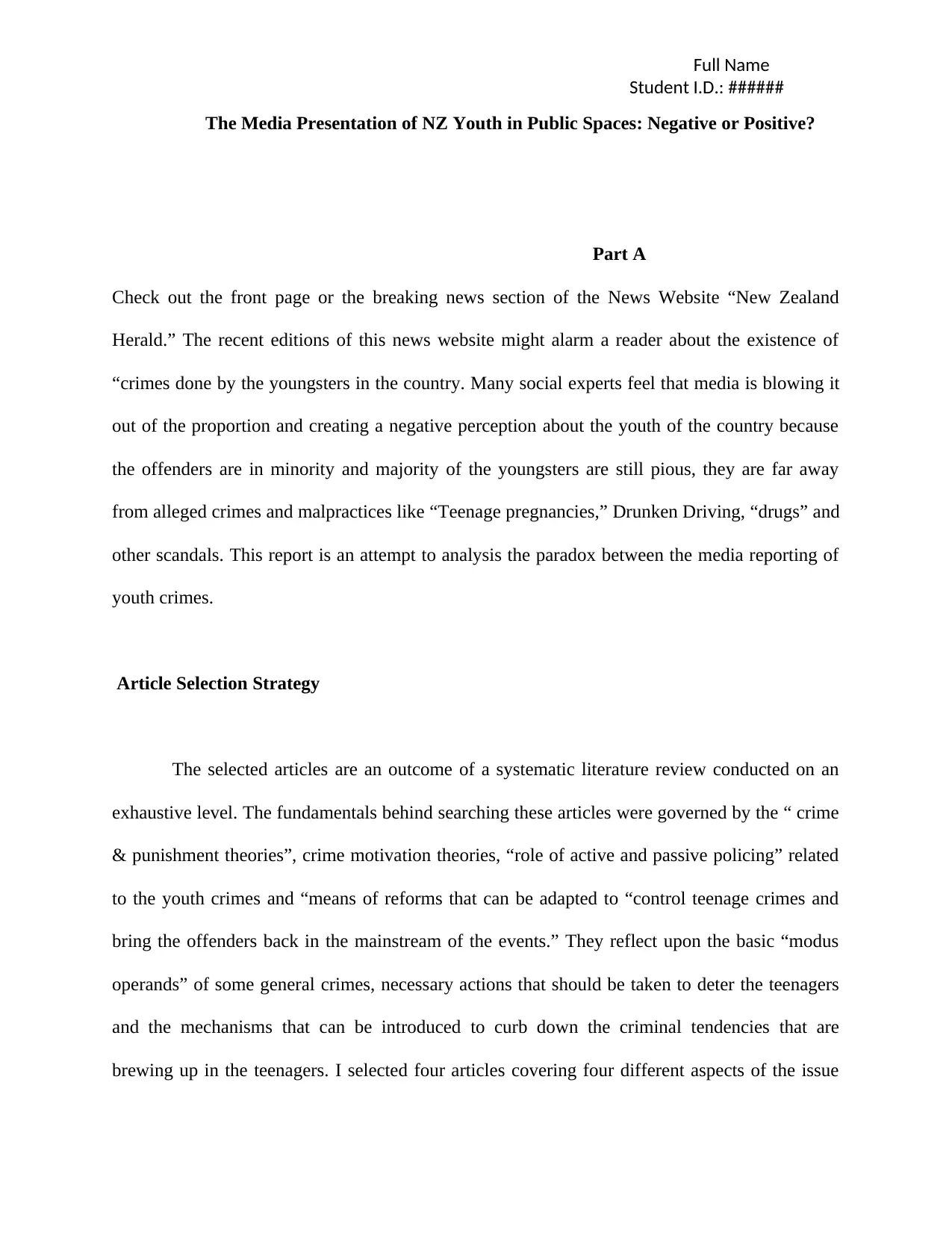
Full Name
Student I.D.: ######
The Media Presentation of NZ Youth in Public Spaces: Negative or Positive?
Part A
Check out the front page or the breaking news section of the News Website “New Zealand
Herald.” The recent editions of this news website might alarm a reader about the existence of
“crimes done by the youngsters in the country. Many social experts feel that media is blowing it
out of the proportion and creating a negative perception about the youth of the country because
the offenders are in minority and majority of the youngsters are still pious, they are far away
from alleged crimes and malpractices like “Teenage pregnancies,” Drunken Driving, “drugs” and
other scandals. This report is an attempt to analysis the paradox between the media reporting of
youth crimes.
Article Selection Strategy
The selected articles are an outcome of a systematic literature review conducted on an
exhaustive level. The fundamentals behind searching these articles were governed by the “ crime
& punishment theories”, crime motivation theories, “role of active and passive policing” related
to the youth crimes and “means of reforms that can be adapted to “control teenage crimes and
bring the offenders back in the mainstream of the events.” They reflect upon the basic “modus
operands” of some general crimes, necessary actions that should be taken to deter the teenagers
and the mechanisms that can be introduced to curb down the criminal tendencies that are
brewing up in the teenagers. I selected four articles covering four different aspects of the issue
Student I.D.: ######
The Media Presentation of NZ Youth in Public Spaces: Negative or Positive?
Part A
Check out the front page or the breaking news section of the News Website “New Zealand
Herald.” The recent editions of this news website might alarm a reader about the existence of
“crimes done by the youngsters in the country. Many social experts feel that media is blowing it
out of the proportion and creating a negative perception about the youth of the country because
the offenders are in minority and majority of the youngsters are still pious, they are far away
from alleged crimes and malpractices like “Teenage pregnancies,” Drunken Driving, “drugs” and
other scandals. This report is an attempt to analysis the paradox between the media reporting of
youth crimes.
Article Selection Strategy
The selected articles are an outcome of a systematic literature review conducted on an
exhaustive level. The fundamentals behind searching these articles were governed by the “ crime
& punishment theories”, crime motivation theories, “role of active and passive policing” related
to the youth crimes and “means of reforms that can be adapted to “control teenage crimes and
bring the offenders back in the mainstream of the events.” They reflect upon the basic “modus
operands” of some general crimes, necessary actions that should be taken to deter the teenagers
and the mechanisms that can be introduced to curb down the criminal tendencies that are
brewing up in the teenagers. I selected four articles covering four different aspects of the issue
⊘ This is a preview!⊘
Do you want full access?
Subscribe today to unlock all pages.

Trusted by 1+ million students worldwide
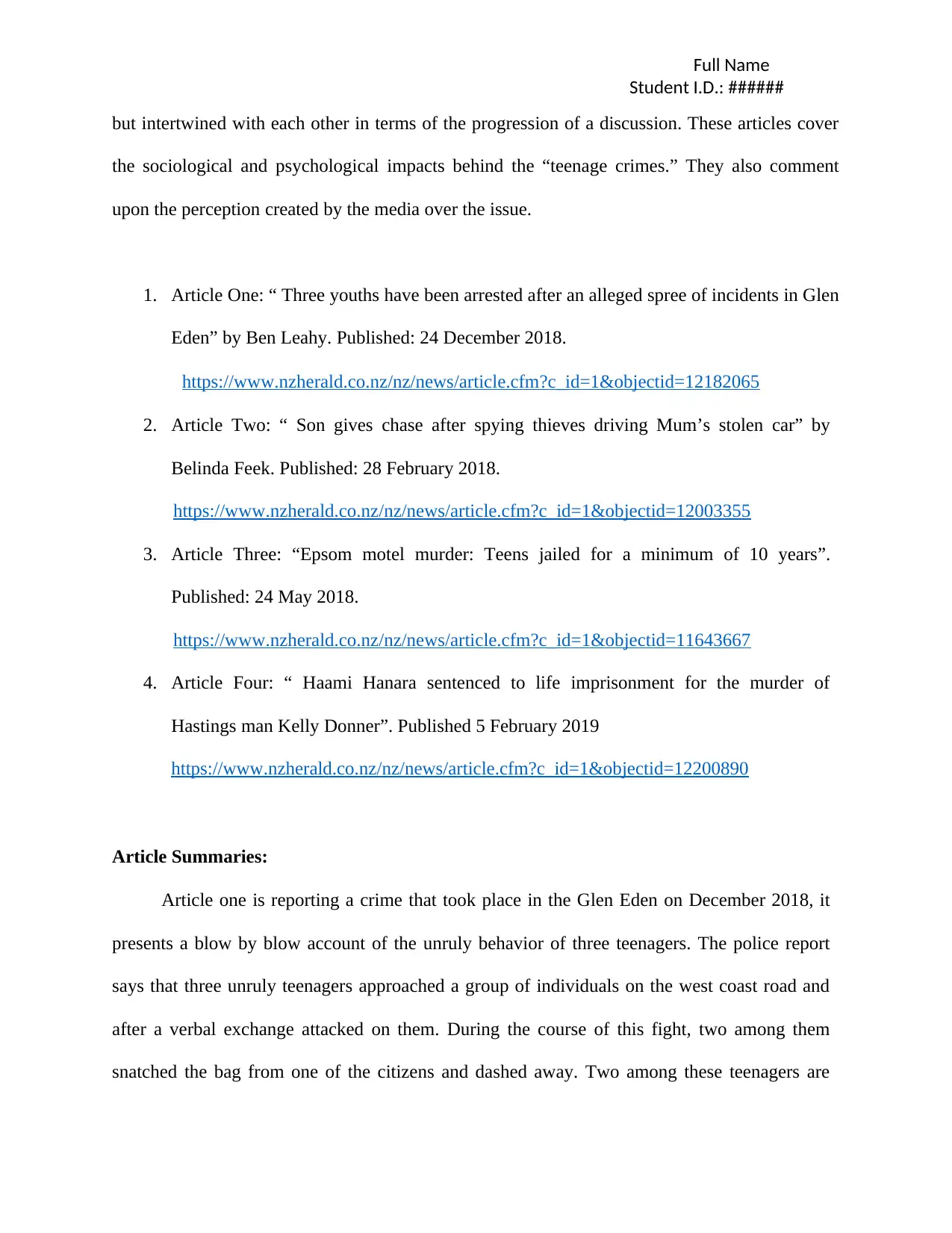
Full Name
Student I.D.: ######
but intertwined with each other in terms of the progression of a discussion. These articles cover
the sociological and psychological impacts behind the “teenage crimes.” They also comment
upon the perception created by the media over the issue.
1. Article One: “ Three youths have been arrested after an alleged spree of incidents in Glen
Eden” by Ben Leahy. Published: 24 December 2018.
https://www.nzherald.co.nz/nz/news/article.cfm?c_id=1&objectid=12182065
2. Article Two: “ Son gives chase after spying thieves driving Mum’s stolen car” by
Belinda Feek. Published: 28 February 2018.
https://www.nzherald.co.nz/nz/news/article.cfm?c_id=1&objectid=12003355
3. Article Three: “Epsom motel murder: Teens jailed for a minimum of 10 years”.
Published: 24 May 2018.
https://www.nzherald.co.nz/nz/news/article.cfm?c_id=1&objectid=11643667
4. Article Four: “ Haami Hanara sentenced to life imprisonment for the murder of
Hastings man Kelly Donner”. Published 5 February 2019
https://www.nzherald.co.nz/nz/news/article.cfm?c_id=1&objectid=12200890
Article Summaries:
Article one is reporting a crime that took place in the Glen Eden on December 2018, it
presents a blow by blow account of the unruly behavior of three teenagers. The police report
says that three unruly teenagers approached a group of individuals on the west coast road and
after a verbal exchange attacked on them. During the course of this fight, two among them
snatched the bag from one of the citizens and dashed away. Two among these teenagers are
Student I.D.: ######
but intertwined with each other in terms of the progression of a discussion. These articles cover
the sociological and psychological impacts behind the “teenage crimes.” They also comment
upon the perception created by the media over the issue.
1. Article One: “ Three youths have been arrested after an alleged spree of incidents in Glen
Eden” by Ben Leahy. Published: 24 December 2018.
https://www.nzherald.co.nz/nz/news/article.cfm?c_id=1&objectid=12182065
2. Article Two: “ Son gives chase after spying thieves driving Mum’s stolen car” by
Belinda Feek. Published: 28 February 2018.
https://www.nzherald.co.nz/nz/news/article.cfm?c_id=1&objectid=12003355
3. Article Three: “Epsom motel murder: Teens jailed for a minimum of 10 years”.
Published: 24 May 2018.
https://www.nzherald.co.nz/nz/news/article.cfm?c_id=1&objectid=11643667
4. Article Four: “ Haami Hanara sentenced to life imprisonment for the murder of
Hastings man Kelly Donner”. Published 5 February 2019
https://www.nzherald.co.nz/nz/news/article.cfm?c_id=1&objectid=12200890
Article Summaries:
Article one is reporting a crime that took place in the Glen Eden on December 2018, it
presents a blow by blow account of the unruly behavior of three teenagers. The police report
says that three unruly teenagers approached a group of individuals on the west coast road and
after a verbal exchange attacked on them. During the course of this fight, two among them
snatched the bag from one of the citizens and dashed away. Two among these teenagers are
Paraphrase This Document
Need a fresh take? Get an instant paraphrase of this document with our AI Paraphraser
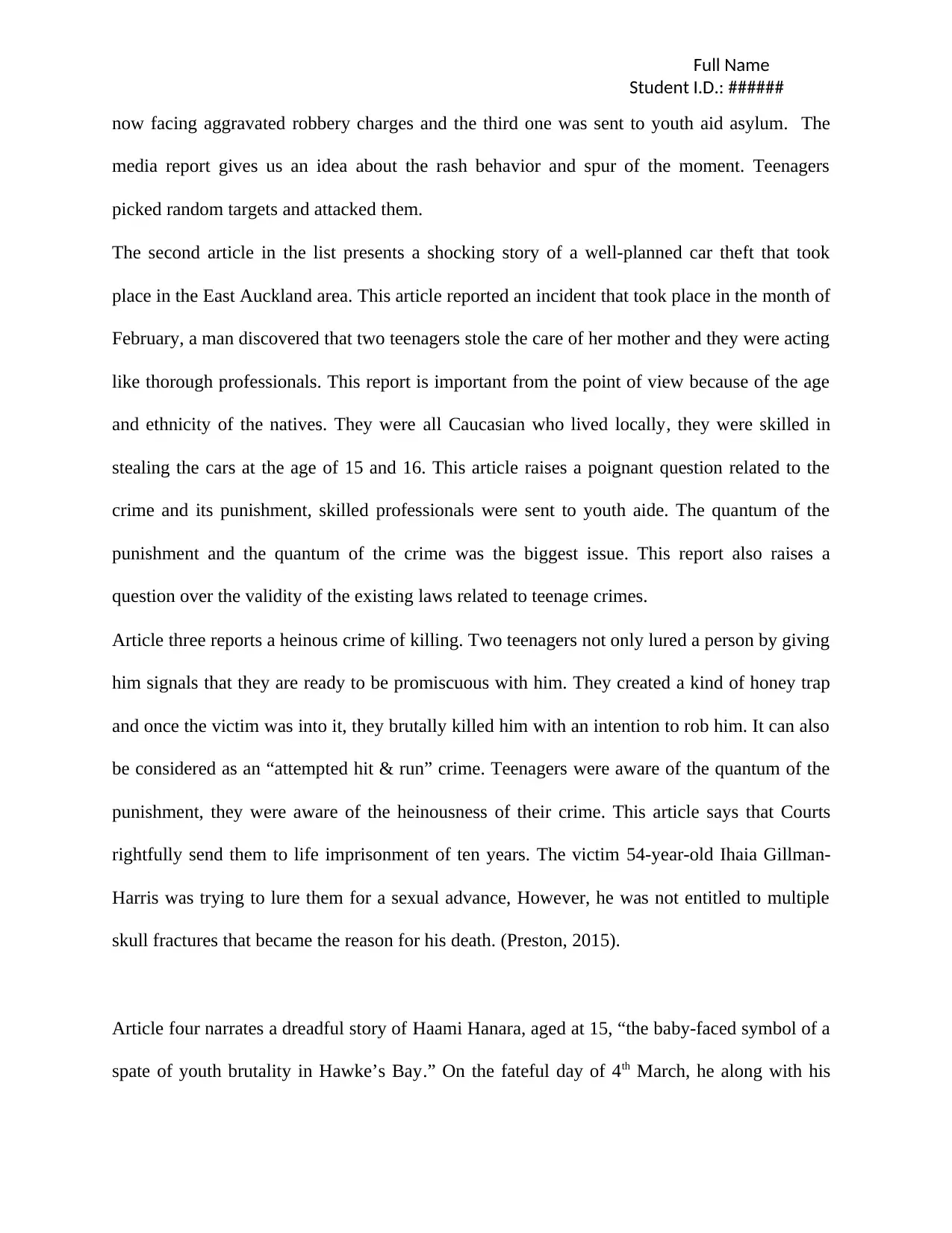
Full Name
Student I.D.: ######
now facing aggravated robbery charges and the third one was sent to youth aid asylum. The
media report gives us an idea about the rash behavior and spur of the moment. Teenagers
picked random targets and attacked them.
The second article in the list presents a shocking story of a well-planned car theft that took
place in the East Auckland area. This article reported an incident that took place in the month of
February, a man discovered that two teenagers stole the care of her mother and they were acting
like thorough professionals. This report is important from the point of view because of the age
and ethnicity of the natives. They were all Caucasian who lived locally, they were skilled in
stealing the cars at the age of 15 and 16. This article raises a poignant question related to the
crime and its punishment, skilled professionals were sent to youth aide. The quantum of the
punishment and the quantum of the crime was the biggest issue. This report also raises a
question over the validity of the existing laws related to teenage crimes.
Article three reports a heinous crime of killing. Two teenagers not only lured a person by giving
him signals that they are ready to be promiscuous with him. They created a kind of honey trap
and once the victim was into it, they brutally killed him with an intention to rob him. It can also
be considered as an “attempted hit & run” crime. Teenagers were aware of the quantum of the
punishment, they were aware of the heinousness of their crime. This article says that Courts
rightfully send them to life imprisonment of ten years. The victim 54-year-old Ihaia Gillman-
Harris was trying to lure them for a sexual advance, However, he was not entitled to multiple
skull fractures that became the reason for his death. (Preston, 2015).
Article four narrates a dreadful story of Haami Hanara, aged at 15, “the baby-faced symbol of a
spate of youth brutality in Hawke’s Bay.” On the fateful day of 4th March, he along with his
Student I.D.: ######
now facing aggravated robbery charges and the third one was sent to youth aid asylum. The
media report gives us an idea about the rash behavior and spur of the moment. Teenagers
picked random targets and attacked them.
The second article in the list presents a shocking story of a well-planned car theft that took
place in the East Auckland area. This article reported an incident that took place in the month of
February, a man discovered that two teenagers stole the care of her mother and they were acting
like thorough professionals. This report is important from the point of view because of the age
and ethnicity of the natives. They were all Caucasian who lived locally, they were skilled in
stealing the cars at the age of 15 and 16. This article raises a poignant question related to the
crime and its punishment, skilled professionals were sent to youth aide. The quantum of the
punishment and the quantum of the crime was the biggest issue. This report also raises a
question over the validity of the existing laws related to teenage crimes.
Article three reports a heinous crime of killing. Two teenagers not only lured a person by giving
him signals that they are ready to be promiscuous with him. They created a kind of honey trap
and once the victim was into it, they brutally killed him with an intention to rob him. It can also
be considered as an “attempted hit & run” crime. Teenagers were aware of the quantum of the
punishment, they were aware of the heinousness of their crime. This article says that Courts
rightfully send them to life imprisonment of ten years. The victim 54-year-old Ihaia Gillman-
Harris was trying to lure them for a sexual advance, However, he was not entitled to multiple
skull fractures that became the reason for his death. (Preston, 2015).
Article four narrates a dreadful story of Haami Hanara, aged at 15, “the baby-faced symbol of a
spate of youth brutality in Hawke’s Bay.” On the fateful day of 4th March, he along with his
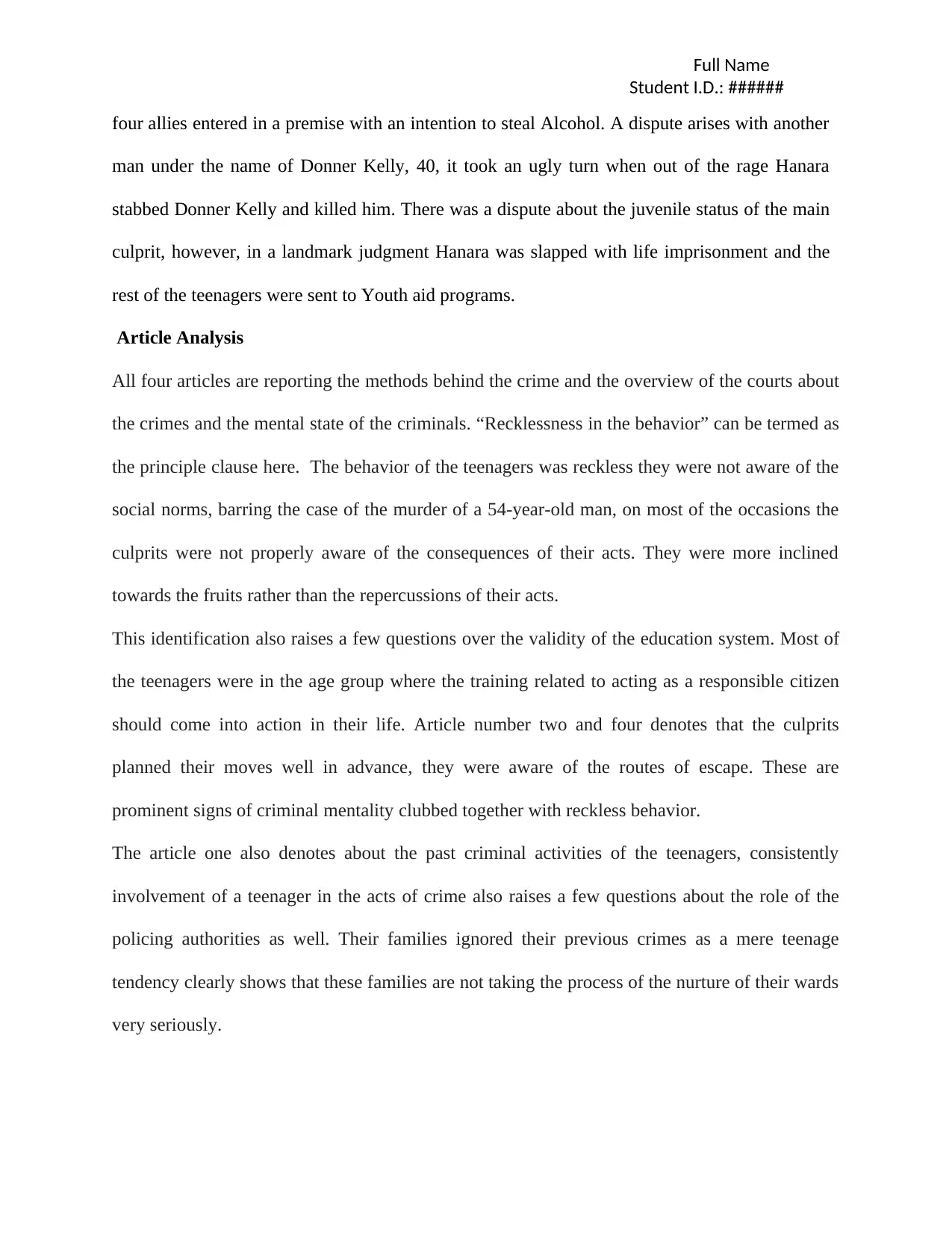
Full Name
Student I.D.: ######
four allies entered in a premise with an intention to steal Alcohol. A dispute arises with another
man under the name of Donner Kelly, 40, it took an ugly turn when out of the rage Hanara
stabbed Donner Kelly and killed him. There was a dispute about the juvenile status of the main
culprit, however, in a landmark judgment Hanara was slapped with life imprisonment and the
rest of the teenagers were sent to Youth aid programs.
Article Analysis
All four articles are reporting the methods behind the crime and the overview of the courts about
the crimes and the mental state of the criminals. “Recklessness in the behavior” can be termed as
the principle clause here. The behavior of the teenagers was reckless they were not aware of the
social norms, barring the case of the murder of a 54-year-old man, on most of the occasions the
culprits were not properly aware of the consequences of their acts. They were more inclined
towards the fruits rather than the repercussions of their acts.
This identification also raises a few questions over the validity of the education system. Most of
the teenagers were in the age group where the training related to acting as a responsible citizen
should come into action in their life. Article number two and four denotes that the culprits
planned their moves well in advance, they were aware of the routes of escape. These are
prominent signs of criminal mentality clubbed together with reckless behavior.
The article one also denotes about the past criminal activities of the teenagers, consistently
involvement of a teenager in the acts of crime also raises a few questions about the role of the
policing authorities as well. Their families ignored their previous crimes as a mere teenage
tendency clearly shows that these families are not taking the process of the nurture of their wards
very seriously.
Student I.D.: ######
four allies entered in a premise with an intention to steal Alcohol. A dispute arises with another
man under the name of Donner Kelly, 40, it took an ugly turn when out of the rage Hanara
stabbed Donner Kelly and killed him. There was a dispute about the juvenile status of the main
culprit, however, in a landmark judgment Hanara was slapped with life imprisonment and the
rest of the teenagers were sent to Youth aid programs.
Article Analysis
All four articles are reporting the methods behind the crime and the overview of the courts about
the crimes and the mental state of the criminals. “Recklessness in the behavior” can be termed as
the principle clause here. The behavior of the teenagers was reckless they were not aware of the
social norms, barring the case of the murder of a 54-year-old man, on most of the occasions the
culprits were not properly aware of the consequences of their acts. They were more inclined
towards the fruits rather than the repercussions of their acts.
This identification also raises a few questions over the validity of the education system. Most of
the teenagers were in the age group where the training related to acting as a responsible citizen
should come into action in their life. Article number two and four denotes that the culprits
planned their moves well in advance, they were aware of the routes of escape. These are
prominent signs of criminal mentality clubbed together with reckless behavior.
The article one also denotes about the past criminal activities of the teenagers, consistently
involvement of a teenager in the acts of crime also raises a few questions about the role of the
policing authorities as well. Their families ignored their previous crimes as a mere teenage
tendency clearly shows that these families are not taking the process of the nurture of their wards
very seriously.
⊘ This is a preview!⊘
Do you want full access?
Subscribe today to unlock all pages.

Trusted by 1+ million students worldwide
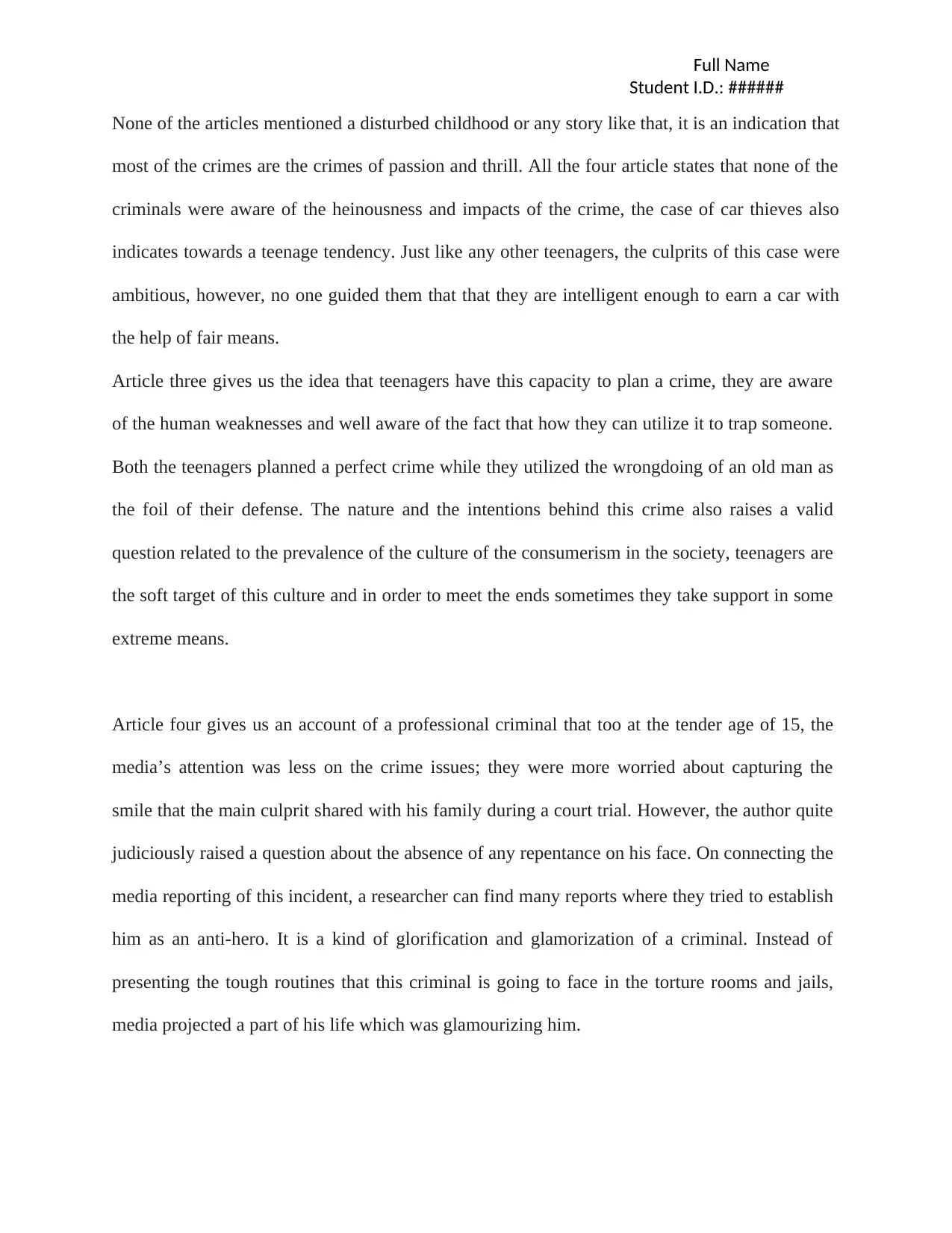
Full Name
Student I.D.: ######
None of the articles mentioned a disturbed childhood or any story like that, it is an indication that
most of the crimes are the crimes of passion and thrill. All the four article states that none of the
criminals were aware of the heinousness and impacts of the crime, the case of car thieves also
indicates towards a teenage tendency. Just like any other teenagers, the culprits of this case were
ambitious, however, no one guided them that that they are intelligent enough to earn a car with
the help of fair means.
Article three gives us the idea that teenagers have this capacity to plan a crime, they are aware
of the human weaknesses and well aware of the fact that how they can utilize it to trap someone.
Both the teenagers planned a perfect crime while they utilized the wrongdoing of an old man as
the foil of their defense. The nature and the intentions behind this crime also raises a valid
question related to the prevalence of the culture of the consumerism in the society, teenagers are
the soft target of this culture and in order to meet the ends sometimes they take support in some
extreme means.
Article four gives us an account of a professional criminal that too at the tender age of 15, the
media’s attention was less on the crime issues; they were more worried about capturing the
smile that the main culprit shared with his family during a court trial. However, the author quite
judiciously raised a question about the absence of any repentance on his face. On connecting the
media reporting of this incident, a researcher can find many reports where they tried to establish
him as an anti-hero. It is a kind of glorification and glamorization of a criminal. Instead of
presenting the tough routines that this criminal is going to face in the torture rooms and jails,
media projected a part of his life which was glamourizing him.
Student I.D.: ######
None of the articles mentioned a disturbed childhood or any story like that, it is an indication that
most of the crimes are the crimes of passion and thrill. All the four article states that none of the
criminals were aware of the heinousness and impacts of the crime, the case of car thieves also
indicates towards a teenage tendency. Just like any other teenagers, the culprits of this case were
ambitious, however, no one guided them that that they are intelligent enough to earn a car with
the help of fair means.
Article three gives us the idea that teenagers have this capacity to plan a crime, they are aware
of the human weaknesses and well aware of the fact that how they can utilize it to trap someone.
Both the teenagers planned a perfect crime while they utilized the wrongdoing of an old man as
the foil of their defense. The nature and the intentions behind this crime also raises a valid
question related to the prevalence of the culture of the consumerism in the society, teenagers are
the soft target of this culture and in order to meet the ends sometimes they take support in some
extreme means.
Article four gives us an account of a professional criminal that too at the tender age of 15, the
media’s attention was less on the crime issues; they were more worried about capturing the
smile that the main culprit shared with his family during a court trial. However, the author quite
judiciously raised a question about the absence of any repentance on his face. On connecting the
media reporting of this incident, a researcher can find many reports where they tried to establish
him as an anti-hero. It is a kind of glorification and glamorization of a criminal. Instead of
presenting the tough routines that this criminal is going to face in the torture rooms and jails,
media projected a part of his life which was glamourizing him.
Paraphrase This Document
Need a fresh take? Get an instant paraphrase of this document with our AI Paraphraser
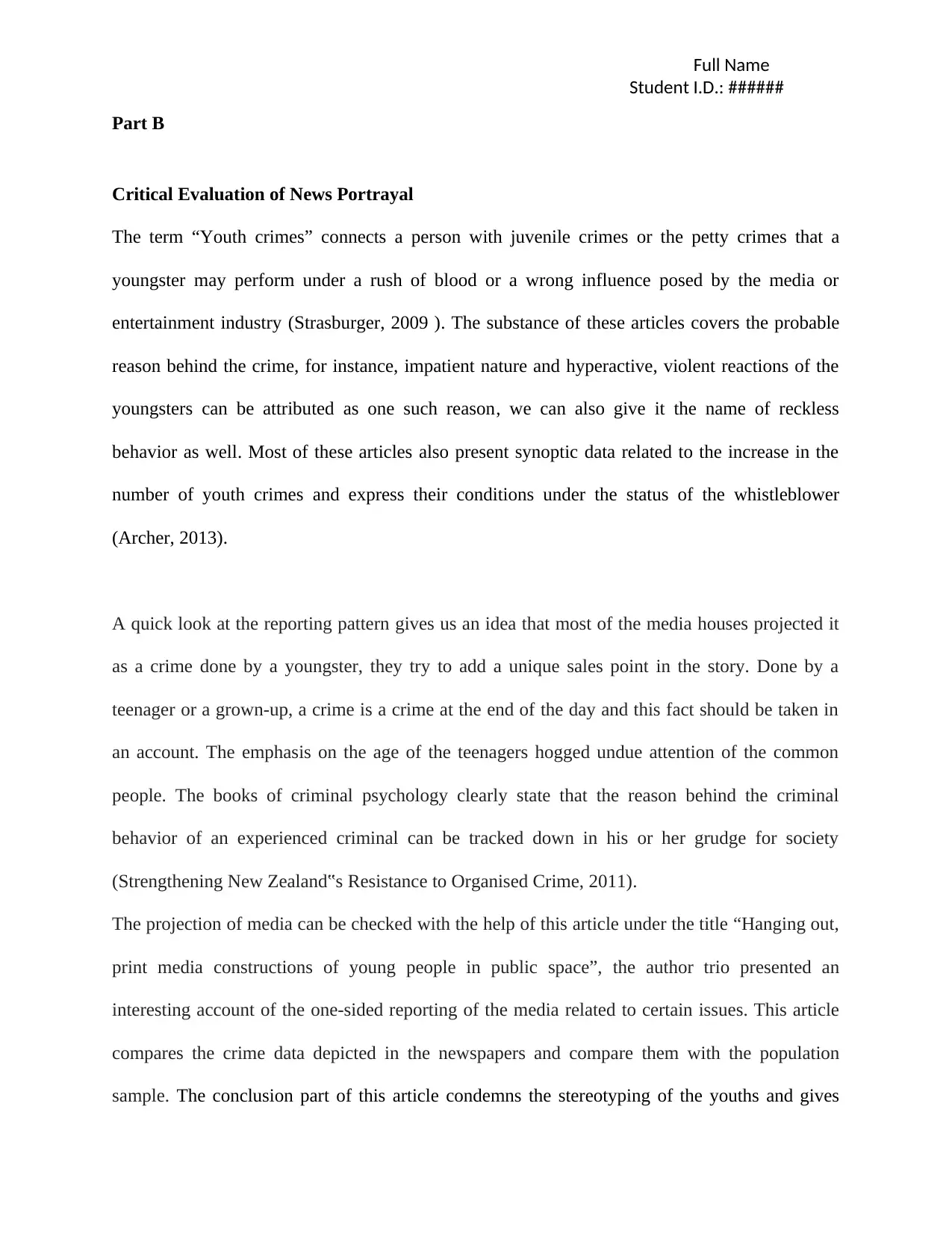
Full Name
Student I.D.: ######
Part B
Critical Evaluation of News Portrayal
The term “Youth crimes” connects a person with juvenile crimes or the petty crimes that a
youngster may perform under a rush of blood or a wrong influence posed by the media or
entertainment industry (Strasburger, 2009 ). The substance of these articles covers the probable
reason behind the crime, for instance, impatient nature and hyperactive, violent reactions of the
youngsters can be attributed as one such reason, we can also give it the name of reckless
behavior as well. Most of these articles also present synoptic data related to the increase in the
number of youth crimes and express their conditions under the status of the whistleblower
(Archer, 2013).
A quick look at the reporting pattern gives us an idea that most of the media houses projected it
as a crime done by a youngster, they try to add a unique sales point in the story. Done by a
teenager or a grown-up, a crime is a crime at the end of the day and this fact should be taken in
an account. The emphasis on the age of the teenagers hogged undue attention of the common
people. The books of criminal psychology clearly state that the reason behind the criminal
behavior of an experienced criminal can be tracked down in his or her grudge for society
(Strengthening New Zealand‟s Resistance to Organised Crime, 2011).
The projection of media can be checked with the help of this article under the title “Hanging out,
print media constructions of young people in public space”, the author trio presented an
interesting account of the one-sided reporting of the media related to certain issues. This article
compares the crime data depicted in the newspapers and compare them with the population
sample. The conclusion part of this article condemns the stereotyping of the youths and gives
Student I.D.: ######
Part B
Critical Evaluation of News Portrayal
The term “Youth crimes” connects a person with juvenile crimes or the petty crimes that a
youngster may perform under a rush of blood or a wrong influence posed by the media or
entertainment industry (Strasburger, 2009 ). The substance of these articles covers the probable
reason behind the crime, for instance, impatient nature and hyperactive, violent reactions of the
youngsters can be attributed as one such reason, we can also give it the name of reckless
behavior as well. Most of these articles also present synoptic data related to the increase in the
number of youth crimes and express their conditions under the status of the whistleblower
(Archer, 2013).
A quick look at the reporting pattern gives us an idea that most of the media houses projected it
as a crime done by a youngster, they try to add a unique sales point in the story. Done by a
teenager or a grown-up, a crime is a crime at the end of the day and this fact should be taken in
an account. The emphasis on the age of the teenagers hogged undue attention of the common
people. The books of criminal psychology clearly state that the reason behind the criminal
behavior of an experienced criminal can be tracked down in his or her grudge for society
(Strengthening New Zealand‟s Resistance to Organised Crime, 2011).
The projection of media can be checked with the help of this article under the title “Hanging out,
print media constructions of young people in public space”, the author trio presented an
interesting account of the one-sided reporting of the media related to certain issues. This article
compares the crime data depicted in the newspapers and compare them with the population
sample. The conclusion part of this article condemns the stereotyping of the youths and gives
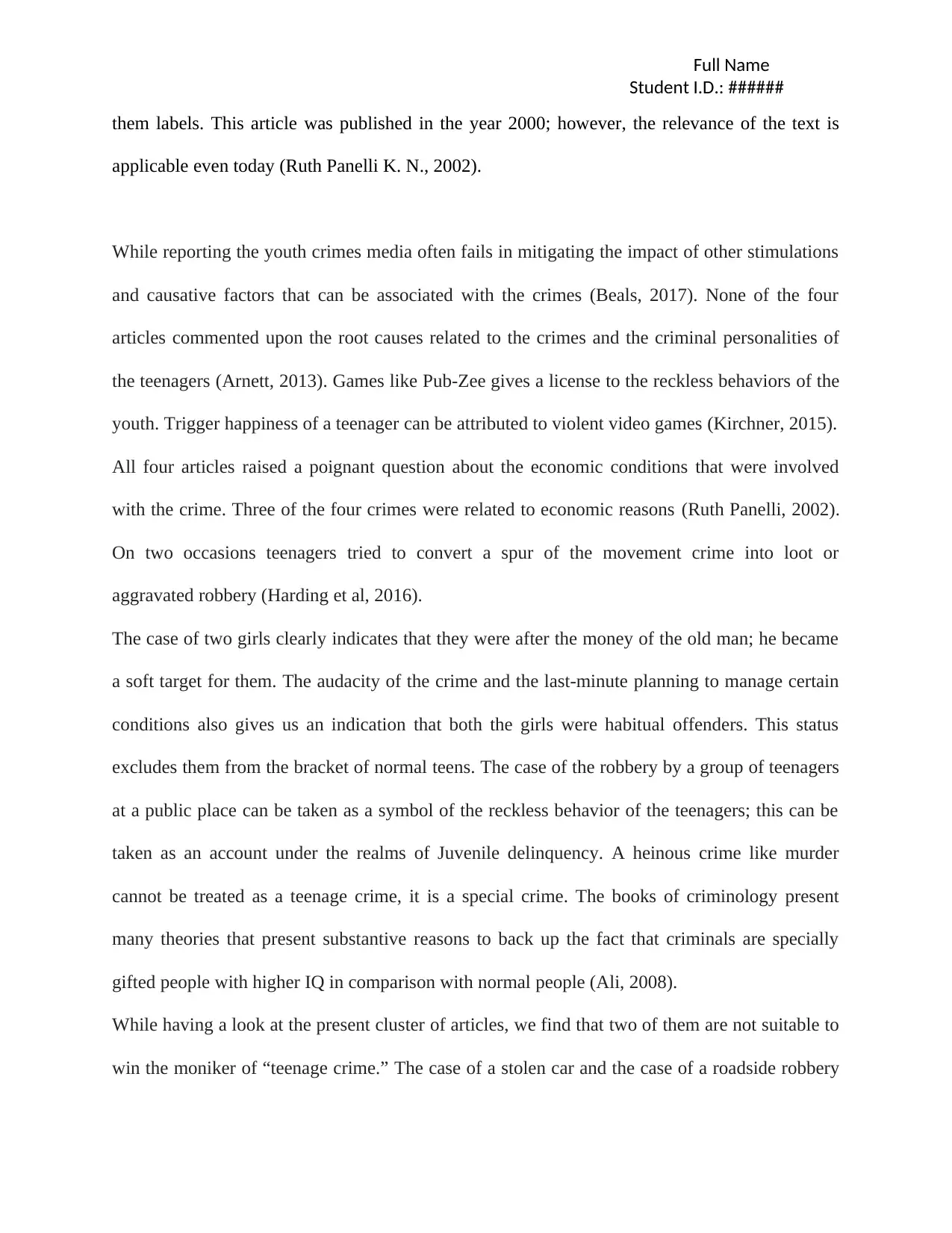
Full Name
Student I.D.: ######
them labels. This article was published in the year 2000; however, the relevance of the text is
applicable even today (Ruth Panelli K. N., 2002).
While reporting the youth crimes media often fails in mitigating the impact of other stimulations
and causative factors that can be associated with the crimes (Beals, 2017). None of the four
articles commented upon the root causes related to the crimes and the criminal personalities of
the teenagers (Arnett, 2013). Games like Pub-Zee gives a license to the reckless behaviors of the
youth. Trigger happiness of a teenager can be attributed to violent video games (Kirchner, 2015).
All four articles raised a poignant question about the economic conditions that were involved
with the crime. Three of the four crimes were related to economic reasons (Ruth Panelli, 2002).
On two occasions teenagers tried to convert a spur of the movement crime into loot or
aggravated robbery (Harding et al, 2016).
The case of two girls clearly indicates that they were after the money of the old man; he became
a soft target for them. The audacity of the crime and the last-minute planning to manage certain
conditions also gives us an indication that both the girls were habitual offenders. This status
excludes them from the bracket of normal teens. The case of the robbery by a group of teenagers
at a public place can be taken as a symbol of the reckless behavior of the teenagers; this can be
taken as an account under the realms of Juvenile delinquency. A heinous crime like murder
cannot be treated as a teenage crime, it is a special crime. The books of criminology present
many theories that present substantive reasons to back up the fact that criminals are specially
gifted people with higher IQ in comparison with normal people (Ali, 2008).
While having a look at the present cluster of articles, we find that two of them are not suitable to
win the moniker of “teenage crime.” The case of a stolen car and the case of a roadside robbery
Student I.D.: ######
them labels. This article was published in the year 2000; however, the relevance of the text is
applicable even today (Ruth Panelli K. N., 2002).
While reporting the youth crimes media often fails in mitigating the impact of other stimulations
and causative factors that can be associated with the crimes (Beals, 2017). None of the four
articles commented upon the root causes related to the crimes and the criminal personalities of
the teenagers (Arnett, 2013). Games like Pub-Zee gives a license to the reckless behaviors of the
youth. Trigger happiness of a teenager can be attributed to violent video games (Kirchner, 2015).
All four articles raised a poignant question about the economic conditions that were involved
with the crime. Three of the four crimes were related to economic reasons (Ruth Panelli, 2002).
On two occasions teenagers tried to convert a spur of the movement crime into loot or
aggravated robbery (Harding et al, 2016).
The case of two girls clearly indicates that they were after the money of the old man; he became
a soft target for them. The audacity of the crime and the last-minute planning to manage certain
conditions also gives us an indication that both the girls were habitual offenders. This status
excludes them from the bracket of normal teens. The case of the robbery by a group of teenagers
at a public place can be taken as a symbol of the reckless behavior of the teenagers; this can be
taken as an account under the realms of Juvenile delinquency. A heinous crime like murder
cannot be treated as a teenage crime, it is a special crime. The books of criminology present
many theories that present substantive reasons to back up the fact that criminals are specially
gifted people with higher IQ in comparison with normal people (Ali, 2008).
While having a look at the present cluster of articles, we find that two of them are not suitable to
win the moniker of “teenage crime.” The case of a stolen car and the case of a roadside robbery
⊘ This is a preview!⊘
Do you want full access?
Subscribe today to unlock all pages.

Trusted by 1+ million students worldwide
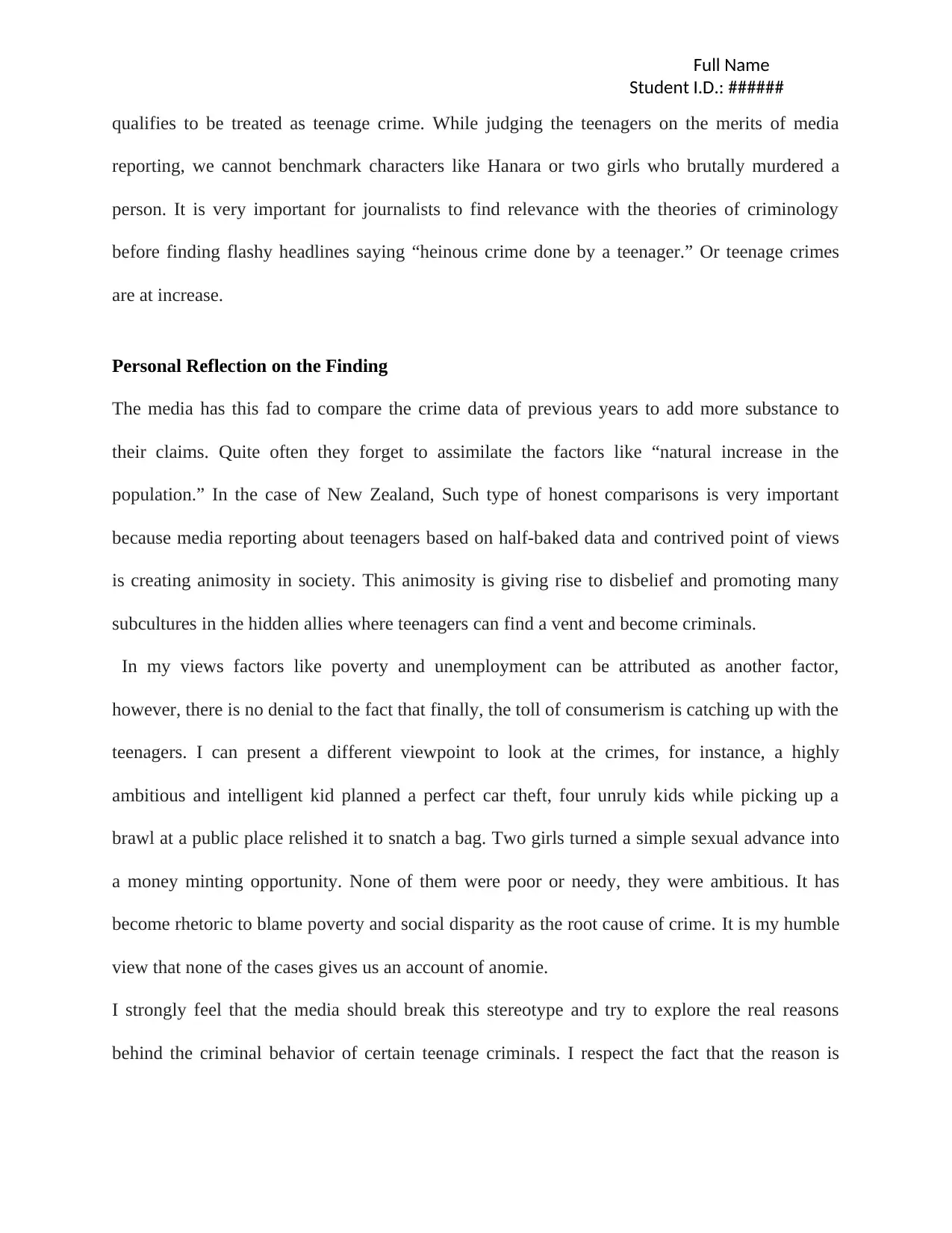
Full Name
Student I.D.: ######
qualifies to be treated as teenage crime. While judging the teenagers on the merits of media
reporting, we cannot benchmark characters like Hanara or two girls who brutally murdered a
person. It is very important for journalists to find relevance with the theories of criminology
before finding flashy headlines saying “heinous crime done by a teenager.” Or teenage crimes
are at increase.
Personal Reflection on the Finding
The media has this fad to compare the crime data of previous years to add more substance to
their claims. Quite often they forget to assimilate the factors like “natural increase in the
population.” In the case of New Zealand, Such type of honest comparisons is very important
because media reporting about teenagers based on half-baked data and contrived point of views
is creating animosity in society. This animosity is giving rise to disbelief and promoting many
subcultures in the hidden allies where teenagers can find a vent and become criminals.
In my views factors like poverty and unemployment can be attributed as another factor,
however, there is no denial to the fact that finally, the toll of consumerism is catching up with the
teenagers. I can present a different viewpoint to look at the crimes, for instance, a highly
ambitious and intelligent kid planned a perfect car theft, four unruly kids while picking up a
brawl at a public place relished it to snatch a bag. Two girls turned a simple sexual advance into
a money minting opportunity. None of them were poor or needy, they were ambitious. It has
become rhetoric to blame poverty and social disparity as the root cause of crime. It is my humble
view that none of the cases gives us an account of anomie.
I strongly feel that the media should break this stereotype and try to explore the real reasons
behind the criminal behavior of certain teenage criminals. I respect the fact that the reason is
Student I.D.: ######
qualifies to be treated as teenage crime. While judging the teenagers on the merits of media
reporting, we cannot benchmark characters like Hanara or two girls who brutally murdered a
person. It is very important for journalists to find relevance with the theories of criminology
before finding flashy headlines saying “heinous crime done by a teenager.” Or teenage crimes
are at increase.
Personal Reflection on the Finding
The media has this fad to compare the crime data of previous years to add more substance to
their claims. Quite often they forget to assimilate the factors like “natural increase in the
population.” In the case of New Zealand, Such type of honest comparisons is very important
because media reporting about teenagers based on half-baked data and contrived point of views
is creating animosity in society. This animosity is giving rise to disbelief and promoting many
subcultures in the hidden allies where teenagers can find a vent and become criminals.
In my views factors like poverty and unemployment can be attributed as another factor,
however, there is no denial to the fact that finally, the toll of consumerism is catching up with the
teenagers. I can present a different viewpoint to look at the crimes, for instance, a highly
ambitious and intelligent kid planned a perfect car theft, four unruly kids while picking up a
brawl at a public place relished it to snatch a bag. Two girls turned a simple sexual advance into
a money minting opportunity. None of them were poor or needy, they were ambitious. It has
become rhetoric to blame poverty and social disparity as the root cause of crime. It is my humble
view that none of the cases gives us an account of anomie.
I strongly feel that the media should break this stereotype and try to explore the real reasons
behind the criminal behavior of certain teenage criminals. I respect the fact that the reason is
Paraphrase This Document
Need a fresh take? Get an instant paraphrase of this document with our AI Paraphraser
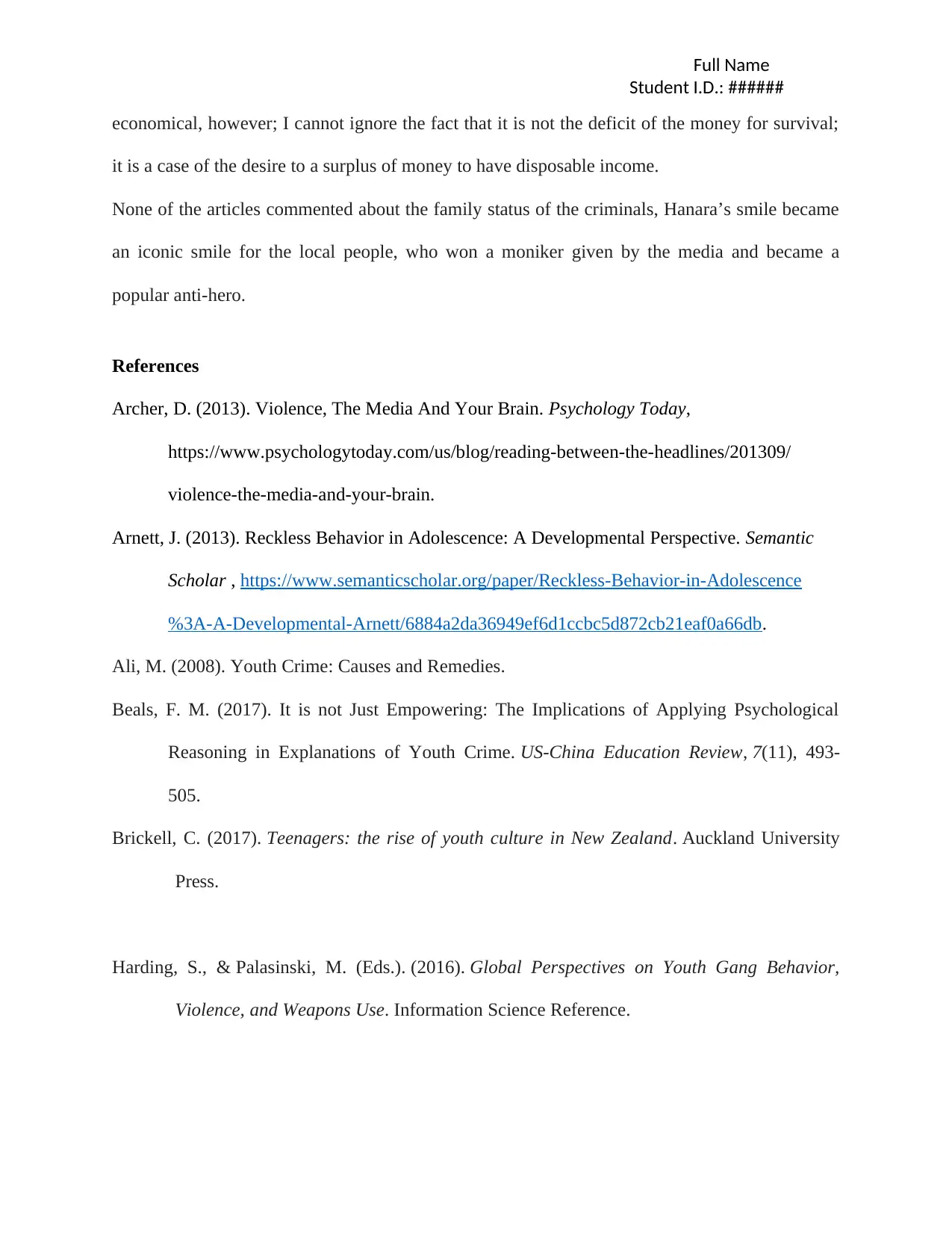
Full Name
Student I.D.: ######
economical, however; I cannot ignore the fact that it is not the deficit of the money for survival;
it is a case of the desire to a surplus of money to have disposable income.
None of the articles commented about the family status of the criminals, Hanara’s smile became
an iconic smile for the local people, who won a moniker given by the media and became a
popular anti-hero.
References
Archer, D. (2013). Violence, The Media And Your Brain. Psychology Today,
https://www.psychologytoday.com/us/blog/reading-between-the-headlines/201309/
violence-the-media-and-your-brain.
Arnett, J. (2013). Reckless Behavior in Adolescence: A Developmental Perspective. Semantic
Scholar , https://www.semanticscholar.org/paper/Reckless-Behavior-in-Adolescence
%3A-A-Developmental-Arnett/6884a2da36949ef6d1ccbc5d872cb21eaf0a66db.
Ali, M. (2008). Youth Crime: Causes and Remedies.
Beals, F. M. (2017). It is not Just Empowering: The Implications of Applying Psychological
Reasoning in Explanations of Youth Crime. US-China Education Review, 7(11), 493-
505.
Brickell, C. (2017). Teenagers: the rise of youth culture in New Zealand. Auckland University
Press.
Harding, S., & Palasinski, M. (Eds.). (2016). Global Perspectives on Youth Gang Behavior,
Violence, and Weapons Use. Information Science Reference.
Student I.D.: ######
economical, however; I cannot ignore the fact that it is not the deficit of the money for survival;
it is a case of the desire to a surplus of money to have disposable income.
None of the articles commented about the family status of the criminals, Hanara’s smile became
an iconic smile for the local people, who won a moniker given by the media and became a
popular anti-hero.
References
Archer, D. (2013). Violence, The Media And Your Brain. Psychology Today,
https://www.psychologytoday.com/us/blog/reading-between-the-headlines/201309/
violence-the-media-and-your-brain.
Arnett, J. (2013). Reckless Behavior in Adolescence: A Developmental Perspective. Semantic
Scholar , https://www.semanticscholar.org/paper/Reckless-Behavior-in-Adolescence
%3A-A-Developmental-Arnett/6884a2da36949ef6d1ccbc5d872cb21eaf0a66db.
Ali, M. (2008). Youth Crime: Causes and Remedies.
Beals, F. M. (2017). It is not Just Empowering: The Implications of Applying Psychological
Reasoning in Explanations of Youth Crime. US-China Education Review, 7(11), 493-
505.
Brickell, C. (2017). Teenagers: the rise of youth culture in New Zealand. Auckland University
Press.
Harding, S., & Palasinski, M. (Eds.). (2016). Global Perspectives on Youth Gang Behavior,
Violence, and Weapons Use. Information Science Reference.
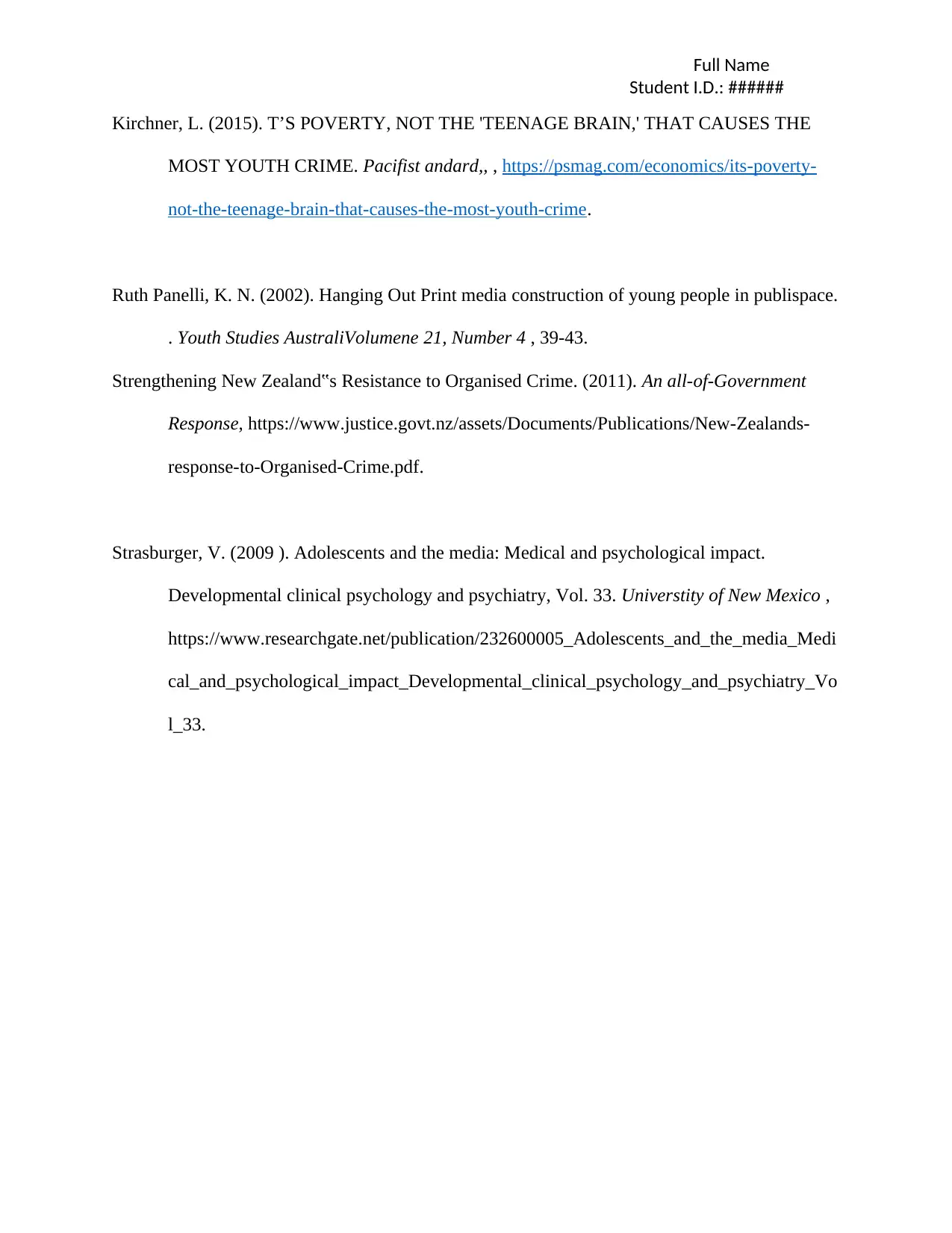
Full Name
Student I.D.: ######
Kirchner, L. (2015). T’S POVERTY, NOT THE 'TEENAGE BRAIN,' THAT CAUSES THE
MOST YOUTH CRIME. Pacifist andard,, , https://psmag.com/economics/its-poverty-
not-the-teenage-brain-that-causes-the-most-youth-crime.
Ruth Panelli, K. N. (2002). Hanging Out Print media construction of young people in publispace.
. Youth Studies AustraliVolumene 21, Number 4 , 39-43.
Strengthening New Zealand‟s Resistance to Organised Crime. (2011). An all-of-Government
Response, https://www.justice.govt.nz/assets/Documents/Publications/New-Zealands-
response-to-Organised-Crime.pdf.
Strasburger, V. (2009 ). Adolescents and the media: Medical and psychological impact.
Developmental clinical psychology and psychiatry, Vol. 33. Universtity of New Mexico ,
https://www.researchgate.net/publication/232600005_Adolescents_and_the_media_Medi
cal_and_psychological_impact_Developmental_clinical_psychology_and_psychiatry_Vo
l_33.
Student I.D.: ######
Kirchner, L. (2015). T’S POVERTY, NOT THE 'TEENAGE BRAIN,' THAT CAUSES THE
MOST YOUTH CRIME. Pacifist andard,, , https://psmag.com/economics/its-poverty-
not-the-teenage-brain-that-causes-the-most-youth-crime.
Ruth Panelli, K. N. (2002). Hanging Out Print media construction of young people in publispace.
. Youth Studies AustraliVolumene 21, Number 4 , 39-43.
Strengthening New Zealand‟s Resistance to Organised Crime. (2011). An all-of-Government
Response, https://www.justice.govt.nz/assets/Documents/Publications/New-Zealands-
response-to-Organised-Crime.pdf.
Strasburger, V. (2009 ). Adolescents and the media: Medical and psychological impact.
Developmental clinical psychology and psychiatry, Vol. 33. Universtity of New Mexico ,
https://www.researchgate.net/publication/232600005_Adolescents_and_the_media_Medi
cal_and_psychological_impact_Developmental_clinical_psychology_and_psychiatry_Vo
l_33.
⊘ This is a preview!⊘
Do you want full access?
Subscribe today to unlock all pages.

Trusted by 1+ million students worldwide
1 out of 13
Your All-in-One AI-Powered Toolkit for Academic Success.
+13062052269
info@desklib.com
Available 24*7 on WhatsApp / Email
![[object Object]](/_next/static/media/star-bottom.7253800d.svg)
Unlock your academic potential
Copyright © 2020–2025 A2Z Services. All Rights Reserved. Developed and managed by ZUCOL.